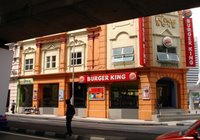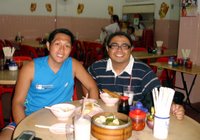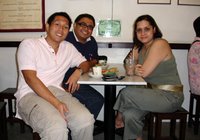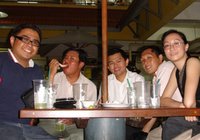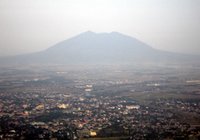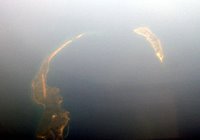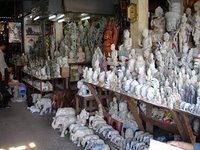 I was up this morning at about 8 a.m. After packing my stuff, we went straight to the Psah Toul Tom Poung or Russian Market where you can find the best souvenirs and Cambodian products, gems and silver, as well as export overruns! I was not expecting to buy a lot of stuff, but it turned out to be a shopping spree and now I'm low on funds. Haha! After buying some replicas of Cambodian temple bas reliefs and bronze Buddha heads, I checked out the export overruns since Mongkol said there were a lot of designer clothes in the U.S. made in Cambodia. I found the store which sold Gap shirts. They could be counterfeit but the colors were just so nice and so Gap! And the shirts... US$2.50 each!!! So I bought all the available colors. Haha!
I was up this morning at about 8 a.m. After packing my stuff, we went straight to the Psah Toul Tom Poung or Russian Market where you can find the best souvenirs and Cambodian products, gems and silver, as well as export overruns! I was not expecting to buy a lot of stuff, but it turned out to be a shopping spree and now I'm low on funds. Haha! After buying some replicas of Cambodian temple bas reliefs and bronze Buddha heads, I checked out the export overruns since Mongkol said there were a lot of designer clothes in the U.S. made in Cambodia. I found the store which sold Gap shirts. They could be counterfeit but the colors were just so nice and so Gap! And the shirts... US$2.50 each!!! So I bought all the available colors. Haha! After shopping, we had a quick breakfast in front of the market. I had pork and rice and lemon juice for a drink. Nice! It was then off to the Tuol Sleng Genocide Museum.
After shopping, we had a quick breakfast in front of the market. I had pork and rice and lemon juice for a drink. Nice! It was then off to the Tuol Sleng Genocide Museum.A former high school that became a prison and interrogation center known as S-21 during the Khmer Rouge regime from 1975 to 1979, it serves as a grim reminder of the reign of terror, the horrors of the Khmer Rouge. They said that once you entered the prison, you will never leave alive.
 According to the brochure, "Out of the roughly 14,200 prisoners at the prison, there were only seven known survivors. Only three of them are thought to be still alive: Vann Nath, Chum Mey and Bou Meng. All three of these men were kept alive because they had skills judged to be useful. Vann Nath had trained as an artist and was put to work painting pictures of Pol Pot. Many of his paintings depicting events he witnessed in Tuol Sleng are on display in the museum to this day. Bou Meng, whose wife was killed in the prison, is also an artist." I was lucky to meet two of them (Vann Nath and Chum Mey) since they were shooting a documentary film at the time we were there. In the photo with me is Chum Mey.
According to the brochure, "Out of the roughly 14,200 prisoners at the prison, there were only seven known survivors. Only three of them are thought to be still alive: Vann Nath, Chum Mey and Bou Meng. All three of these men were kept alive because they had skills judged to be useful. Vann Nath had trained as an artist and was put to work painting pictures of Pol Pot. Many of his paintings depicting events he witnessed in Tuol Sleng are on display in the museum to this day. Bou Meng, whose wife was killed in the prison, is also an artist." I was lucky to meet two of them (Vann Nath and Chum Mey) since they were shooting a documentary film at the time we were there. In the photo with me is Chum Mey. Here is some text from the museum brochure about the horrors of S-21 which is also found in Wikipedia: "Quality of life of the prisoners at Tuol Sleng was terribly harsh. Upon arrival at the prison, the prisoners were photographed and required to give complete biographical information. After that, they were forced to strip naked, and all their possessions were removed. The prisoners were then taken to their cells. Those taken to the smaller cells were shackled to the walls. Those who were held in the large mass cells were collectively shackled to long pieces of iron bar. The prisoners had to sleep on the cold floors, while still shackled.
Here is some text from the museum brochure about the horrors of S-21 which is also found in Wikipedia: "Quality of life of the prisoners at Tuol Sleng was terribly harsh. Upon arrival at the prison, the prisoners were photographed and required to give complete biographical information. After that, they were forced to strip naked, and all their possessions were removed. The prisoners were then taken to their cells. Those taken to the smaller cells were shackled to the walls. Those who were held in the large mass cells were collectively shackled to long pieces of iron bar. The prisoners had to sleep on the cold floors, while still shackled. The prison had very strict regulations, and severe beatings were inflicted upon any prisoner who tried to disobey. Almost every action had to be approved by one of the prison's guards. Likewise, health conditions were awful. The unhygienic living conditions caused skin diseases, lice, and other ailments, and few of the inmates ever received any kind of treatment."
The prison had very strict regulations, and severe beatings were inflicted upon any prisoner who tried to disobey. Almost every action had to be approved by one of the prison's guards. Likewise, health conditions were awful. The unhygienic living conditions caused skin diseases, lice, and other ailments, and few of the inmates ever received any kind of treatment."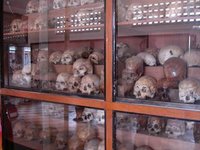 Seeing the individual torture rooms and photos of the victims when the Vietnames found them in 1979 was just horrible. The cells of the prisoners were so small. They were shackled to the floor so they couldn't move. It's hard to imagine how life was for them. At the end of the last building was a shelf with the remains of some of the victims of S-21. Sigh!
Seeing the individual torture rooms and photos of the victims when the Vietnames found them in 1979 was just horrible. The cells of the prisoners were so small. They were shackled to the floor so they couldn't move. It's hard to imagine how life was for them. At the end of the last building was a shelf with the remains of some of the victims of S-21. Sigh! Anyway, time was running out. We went back to Mongkol's place for a while so that I could repack my stuff and put in the stuff I bought. With that done, it was off to the bus station. But not before I was able to get a photo at the Independence Monument. Hehe!
Anyway, time was running out. We went back to Mongkol's place for a while so that I could repack my stuff and put in the stuff I bought. With that done, it was off to the bus station. But not before I was able to get a photo at the Independence Monument. Hehe!We arrived just in time. And after a photo and a short goodbye, I was off to Siem Reap, deep in the heart of Cambodia. The bus ride was going to take about six hours but it was most definitely worth it since one would be rewarded with the best views of the Cambodian coutryside.
 The good thing about the bus was it had a bathroom at the back and a bus stewardess who gave us wet towels, a box of pastries, and mineral water. She also made announcements where we were stopping over and gave short descriptions of important places as we passed by. Maybe Victory Liner and other bus companies could learn a thing or two from here. Although I heard that Victory started a new bus service to Baguio which had bigger chairs and a stewardess.
The good thing about the bus was it had a bathroom at the back and a bus stewardess who gave us wet towels, a box of pastries, and mineral water. She also made announcements where we were stopping over and gave short descriptions of important places as we passed by. Maybe Victory Liner and other bus companies could learn a thing or two from here. Although I heard that Victory started a new bus service to Baguio which had bigger chairs and a stewardess.Anyway, I arrived here at about 6 p.m. Since Sok had an uncle who just opened a new guest house in Siem Reap, he made arrangements for me. His cousin picked me up at the bus terminal. The place, Heng Khim Guest House is very new and charges US$10 a night for a comfortable air-conditioned room. Although it's a bit far from the town center, their staff were kind enough to take me here where I had dinner. If you want to contact them, Chea Hak's mobile number is (012) 97 19 79 or (016) 67 77 87.
 Dinner was fried rice noodles with pork which I had at a place near the internet cafe. I'm off to bed now. I want to make the most out of the US$20 day pass at the Angkor National Park. Hehe!
Dinner was fried rice noodles with pork which I had at a place near the internet cafe. I'm off to bed now. I want to make the most out of the US$20 day pass at the Angkor National Park. Hehe!













